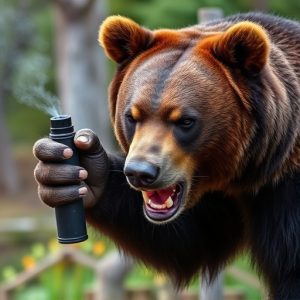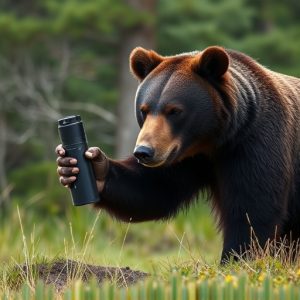Surviving Grizzly Attacks: Sense of Smell, Bear Spray Ingredient Secrets & Beyond
Grizzly bears' powerful sense of smell and defensive charging behavior pose challenges for adve…….
Grizzly bears' powerful sense of smell and defensive charging behavior pose challenges for adventurers. Bear spray, containing capsaicin and PBC, is an effective deterrant but must be used correctly and remain potent (with a valid 'use by' date). Aim at the bear's face and eyes during a charge. Combine bear spray with noise-making, maintaining distance from feeding areas, and using objects as weapons to enhance safety.
In the vast wilderness, encountering a charging grizzly bear can be a terrifying reality. Understanding these formidable creatures and their behavior is crucial for safety. This article equips readers with essential knowledge about grizzly bears’ acute sense of smell and their unpredictable nature. We delve into the effectiveness of bear spray, exploring what it contains and whether it expires. Additionally, discover beyond-spray strategies to defend against aggressive bears, ensuring a safer wilderness experience.
- Understanding Grizzly Bear Behavior and Their Sense of Smell
- What is Bear Spray and How Does It Work? Ingredients to Look Out For
- Effective Strategies for Defending Against Charging Grizzlies: Beyond Bear Spray
Understanding Grizzly Bear Behavior and Their Sense of Smell
Grizzly bears are powerful and unpredictable animals, and understanding their behavior is crucial for anyone venturing into their wilderness habitat. These bears have an exceptional sense of smell, which they use to locate food sources and navigate their environment. They can detect odors from miles away, making it essential for hikers and campers to be aware of this fact. When faced with a potential threat or prey, grizzlies may charge as a defensive mechanism. This behavior is often triggered by feeling cornered, protecting their cubs, or sensing food nearby.
Bear spray, a popular defense mechanism against charging bears, contains capsaicin, the active ingredient found in chili peppers. While it does not expire in the traditional sense, its effectiveness decreases over time. The expiration date typically refers to the point when the formula’s potency and potency may start to diminish, so users should check product labels for specific guidelines. Proper usage involves aiming for the bear’s face and eyes, which can deter them long enough for you to escape or seek refuge.
What is Bear Spray and How Does It Work? Ingredients to Look Out For
Bear spray is a powerful deterrent designed to protect individuals from aggressive bears, particularly grizzlies. It’s a type of pepper spray specifically formulated for outdoor use and comes in various forms, including cans and aerosol bottles. When used correctly, bear spray creates an intense irritation in a bear’s eyes and nose, temporarily disorienting it and giving you valuable time to escape or defend yourself.
The key to effective bear spray lies in its ingredients. Look for products containing capsaicin, the active ingredient found in chili peppers, as well as other compounds like piperidinyl butyl carbamate (PBC). These ingredients are known to cause a burning sensation and severe irritation when inhaled by bears. Ensure the spray has a range of at least 20 feet and is labeled for bear deterrence. Regularly checking the expiration date is crucial, as bear spray can degrade over time, especially in extreme conditions, so always opt for products with a valid ‘use by’ date to guarantee their effectiveness when you need them most.
Effective Strategies for Defending Against Charging Grizzlies: Beyond Bear Spray
When faced with a charging grizzly bear, instinct might tell you to reach for bear spray—but it’s only one tool in your defense arsenal. While bear spray can be effective, understanding other strategies is crucial for a comprehensive approach to safety. Beyond bear spray, knowing how to respond and what actions to take can significantly increase your chances of escaping an encounter unscathed.
For instance, making noise before and during an encounter can deter bears, as they often avoid confrontations. Wearing loud clothing or carrying noisemakers can help signal your presence. Additionally, maintaining a safe distance and avoiding areas where bears are known to feed—such as near streams or in dense vegetation—can significantly reduce the risk of an attack. If a charge occurs, playing dead is not always advised. Instead, try to fight back aggressively using any available object as a weapon. The key is to defend yourself persuasively while keeping your distance from the bear’s reach.
While bear spray remains a crucial defense against charging grizzlies, understanding bear behavior and ingredient quality is key. Regularly checking expiration dates ensures its effectiveness. Beyond spray, adopting strategic retreats and making noise to signal your presence can significantly enhance safety in wild environments. Remember, knowledge and preparation are essential tools for navigating encounters with these majestic yet powerful creatures.


